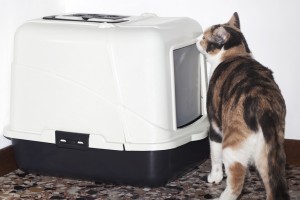 Cats that suddenly refuse to use the litter box might be telling you something’s wrong.
Cats that suddenly refuse to use the litter box might be telling you something’s wrong.
Feline lower urinary tract disease (FLUTD) is the name used to describe a number of urinary problems in cats. FLUTD includes everything from bloody urine to licking the urinary opening to straining to urinate.
Here’s how to identify if your baby is suffering from this kind of condition.
Some cats show pain when urinating, while others will take to urinating in different corners of the house instead of using the litter box.
All these can be signs that something’s wrong and a visit to the vet is in order.
A word of warning: if a male cat is not urinating and is straining, crying out, or hunched over, this is an EMERGENCY and you should proceed to your veterinarian office IMMEDIATELY! This could indicate a blockage, where tiny bladder stones completely block the urethra and prevent urine from flowing through.
Because toxins are eliminated through the urine, not being able to urinate leads to toxin accumulation in the body. Left untreated, blockages can be fatal in as little as three days.
Other signs to watch out for include:
- Visiting the litter box more frequently. If kitty used to urinate 3-4 times a day and now he’s in the litter box twice as often, this could be a sign of trouble.
- Cloudy urine (which could be a sign of protein in the urine and/or an infection)
- Crying when trying to urinate
- Loss of bladder control (kitty can’t make it to the litter box and “dribbles” along the way)
- Unusual smell in the urine (usually very strong, ammonia-like)
- Bloated stomach that’s hard to the touch
- Lethargy
What’s Wrong With Your Cat?
The only way to determine what’s causing urinary problems is to have a series of tests. A combination of urinalysis and a blood test often provides a clear picture so your vet can decide on the best course of treatment.
A common cause for urinary problems is a bladder infection or inflammation. Bladder or urethra stones, a weak bladder, or spinal cord problems are also possible. In some cases, the presence of a tumor in the urinary tract can also lead to urinary issues.
Cats that are diabetic often have problems with their lower urinary tract. In fact, urinary issues and excessive drinking are two of the most obvious signs of diabetes and often appear before you notice anything else.
Finally, some cats are very sensitive to stress and will take to urinating outside the litter box as a reaction to it. If you’ve recently moved, introduced a new pet (or baby) to the house or some other major change is taking place, let your vet know. This can help determine how to help kitty better. Sometimes adding a second litter box is a good solution, especially if you have a cat that objects to sharing with a second pet or if you have a large house and finding the one litter box takes a lot of work. You can also try a litter called Cat Attract to assist in litter box use. Consult with your veterinarian to see if this would be an appropriate litter for your kitty.
Although most urinary problems are treatable, the sooner you get to your vet, the easier it will be to deal with it without complications.

